Deck 48: Osmoregulation and Disposal of Metabolic Wastes
Question
Question
Question
Question
Question
Question
Question
Question
Question
Question
Question
Question
Question
Question
Question
Question
Question
Question
Question
Question
Question
Question
Question
Question
Question
Question
Question
Question
Question
Question
Question
Question
Question
Question
Question
Question
Question
Question
Question
Question
Question
Question
Question
Question
Question
Question
Question
Question
Question
Question
Question
Question
Question
Question
Question
Question
Question
Question
Question
Question
Question
Question
Question
Question
Question
Question
Question
Question
Question
Match between columns
Question
Question
Question
Question
Question
Question
Match between columns
Question
Question
Question
Question
Question

Unlock Deck
Sign up to unlock the cards in this deck!
Unlock Deck
Unlock Deck
1/111
Play
Full screen (f)
Deck 48: Osmoregulation and Disposal of Metabolic Wastes
1
The main point of entry of water into the blood of freshwater fishes is through the:
A) skin.
B) gills.
C) tail.
D) anus.
E) eyes.
A) skin.
B) gills.
C) tail.
D) anus.
E) eyes.
B
2
Metanephridial organs are common in:
A) mollusks.
B) flatworms.
C) cnidarians.
D) sponges.
E) insects.
A) mollusks.
B) flatworms.
C) cnidarians.
D) sponges.
E) insects.
A
3
What is one disadvantage of excreting urea as opposed to uric acid?
A) Urea is more toxic than uric acid.
B) Urea is less toxic than uric acid.
C) Urea is excreted by respiratory structures.
D) Urea requires more water for excretion.
E) Urea is produced from ammonia, not nucleic acids.
A) Urea is more toxic than uric acid.
B) Urea is less toxic than uric acid.
C) Urea is excreted by respiratory structures.
D) Urea requires more water for excretion.
E) Urea is produced from ammonia, not nucleic acids.
D
4
The excretory system of insects:
A) has many openings on the body wall.
B) contains flame cells.
C) is not connected to the gut.
D) excretes uric acid from the rectum.
E) relies on diffusion across the body wall.
A) has many openings on the body wall.
B) contains flame cells.
C) is not connected to the gut.
D) excretes uric acid from the rectum.
E) relies on diffusion across the body wall.

Unlock Deck
Unlock for access to all 111 flashcards in this deck.
Unlock Deck
k this deck
5
Figure 48-2 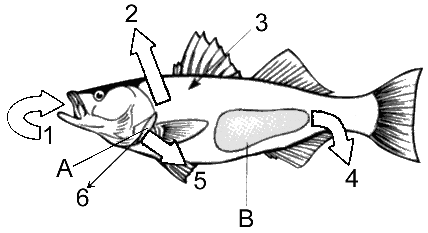 Refer to the accompanying figure in terms of a marine environment. What is the function of the structure labeled as A?
Refer to the accompanying figure in terms of a marine environment. What is the function of the structure labeled as A?
A) salt excretion
B) water gain by osmosis
C) drinking
D) removal of salts and nitrogenous wastes from the blood
E) release of nitrogenous wastes
 Refer to the accompanying figure in terms of a marine environment. What is the function of the structure labeled as A?
Refer to the accompanying figure in terms of a marine environment. What is the function of the structure labeled as A?A) salt excretion
B) water gain by osmosis
C) drinking
D) removal of salts and nitrogenous wastes from the blood
E) release of nitrogenous wastes

Unlock Deck
Unlock for access to all 111 flashcards in this deck.
Unlock Deck
k this deck
6
The main nitrogenous waste of freshwater fishes is:
A) ammonia.
B) urea.
C) uric acid.
D) amino acids.
E) purines.
A) ammonia.
B) urea.
C) uric acid.
D) amino acids.
E) purines.

Unlock Deck
Unlock for access to all 111 flashcards in this deck.
Unlock Deck
k this deck
7
Which nitrogenous waste product would be least toxic to an embryo developing in the aqueous environment found inside a shelled egg?
A) ammonia
B) urea
C) uric acid
D) amino acids
E) purines
A) ammonia
B) urea
C) uric acid
D) amino acids
E) purines

Unlock Deck
Unlock for access to all 111 flashcards in this deck.
Unlock Deck
k this deck
8
Which of the following relationships is accurate?
A) insects: Malpighian tubules: urea as major nitrogenous waste
B) annelids: protonephridia: ammonia as major nitrogenous waste
C) freshwater fish: kidney: large volume of hypertonic urine
D) sharks: kidney: large volume of hypotonic urine
E) earthworm: kidney: ammonia as major nitrogenous waste
A) insects: Malpighian tubules: urea as major nitrogenous waste
B) annelids: protonephridia: ammonia as major nitrogenous waste
C) freshwater fish: kidney: large volume of hypertonic urine
D) sharks: kidney: large volume of hypotonic urine
E) earthworm: kidney: ammonia as major nitrogenous waste

Unlock Deck
Unlock for access to all 111 flashcards in this deck.
Unlock Deck
k this deck
9
Figure 48-1 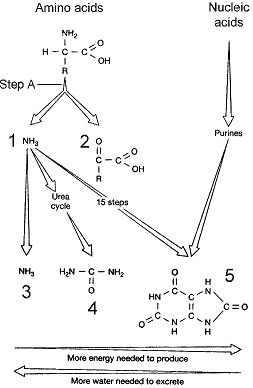 The process represented at step A of the accompanying figure is referred to as:
The process represented at step A of the accompanying figure is referred to as:
A) filtration.
B) secretion.
C) excretion.
D) deamination.
E) elimination.
 The process represented at step A of the accompanying figure is referred to as:
The process represented at step A of the accompanying figure is referred to as:A) filtration.
B) secretion.
C) excretion.
D) deamination.
E) elimination.

Unlock Deck
Unlock for access to all 111 flashcards in this deck.
Unlock Deck
k this deck
10
Figure 48-1 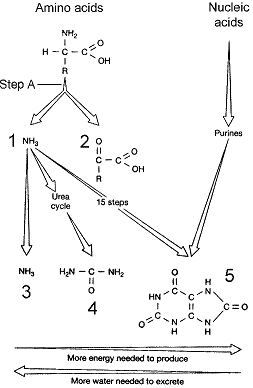 Refer to the accompanying figure. Which compound is the primary nitrogenous waste product of amphibians?
Refer to the accompanying figure. Which compound is the primary nitrogenous waste product of amphibians?
A) 1
B) 2
C) 3
D) 4
E) 5
 Refer to the accompanying figure. Which compound is the primary nitrogenous waste product of amphibians?
Refer to the accompanying figure. Which compound is the primary nitrogenous waste product of amphibians?A) 1
B) 2
C) 3
D) 4
E) 5

Unlock Deck
Unlock for access to all 111 flashcards in this deck.
Unlock Deck
k this deck
11
Osmoconformers would most likely be found in:
A) estuaries.
B) coastal zones that receive freshwater.
C) freshwater.
D) terrestrial habitats.
E) open ocean waters.
A) estuaries.
B) coastal zones that receive freshwater.
C) freshwater.
D) terrestrial habitats.
E) open ocean waters.

Unlock Deck
Unlock for access to all 111 flashcards in this deck.
Unlock Deck
k this deck
12
Figure 48-1 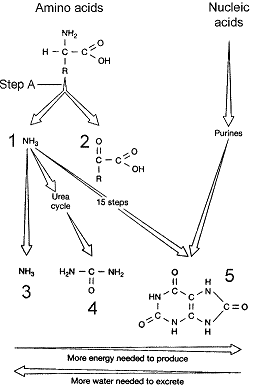 Which structure in the accompanying figure represents the nitrogenous waste urea?
Which structure in the accompanying figure represents the nitrogenous waste urea?
A) 1
B) 2
C) 3
D) 4
E) 5
 Which structure in the accompanying figure represents the nitrogenous waste urea?
Which structure in the accompanying figure represents the nitrogenous waste urea?A) 1
B) 2
C) 3
D) 4
E) 5

Unlock Deck
Unlock for access to all 111 flashcards in this deck.
Unlock Deck
k this deck
13
Deamination is a process that removes:
A) the amino group from amino acids.
B) the amino group from nucleic acids.
C) amines from the bloodstream.
D) amines from nucleic acids.
E) ammonia from blood.
A) the amino group from amino acids.
B) the amino group from nucleic acids.
C) amines from the bloodstream.
D) amines from nucleic acids.
E) ammonia from blood.

Unlock Deck
Unlock for access to all 111 flashcards in this deck.
Unlock Deck
k this deck
14
The main osmoregulatory and excretory organ in most vertebrates is the:
A) skin.
B) gill.
C) metanephridium.
D) lung.
E) kidney.
A) skin.
B) gill.
C) metanephridium.
D) lung.
E) kidney.

Unlock Deck
Unlock for access to all 111 flashcards in this deck.
Unlock Deck
k this deck
15
Which of the following is a nitrogenous waste of animals?
A) amino acids
B) carbon dioxide
C) ammonia
D) water
E) sugars
A) amino acids
B) carbon dioxide
C) ammonia
D) water
E) sugars

Unlock Deck
Unlock for access to all 111 flashcards in this deck.
Unlock Deck
k this deck
16
The major function of the protonephridia in the flatworm is to:
A) conserve water.
B) conserve salts.
C) eliminate waste materials such as ammonia and urea.
D) eliminate excess water.
E) regulate the pH of the gastrovascular cavity.
A) conserve water.
B) conserve salts.
C) eliminate waste materials such as ammonia and urea.
D) eliminate excess water.
E) regulate the pH of the gastrovascular cavity.

Unlock Deck
Unlock for access to all 111 flashcards in this deck.
Unlock Deck
k this deck
17
Which statement about the Malpighian tubules is FALSE?
A) Water and some solutes are transported into the Malpighian tubules via active transport.
B) The Malpighian tubules empty into the gut of the insect.
C) Water, some salts, and other solutes are reabsorbed into the hemolymph in the rectum.
D) The excretory system of an insect may contain up to several hundred Malpighian tubules.
E) The blind ends of the Malpighian tubules are bathed in hemolymph.
A) Water and some solutes are transported into the Malpighian tubules via active transport.
B) The Malpighian tubules empty into the gut of the insect.
C) Water, some salts, and other solutes are reabsorbed into the hemolymph in the rectum.
D) The excretory system of an insect may contain up to several hundred Malpighian tubules.
E) The blind ends of the Malpighian tubules are bathed in hemolymph.

Unlock Deck
Unlock for access to all 111 flashcards in this deck.
Unlock Deck
k this deck
18
How do terrestrial animals prevent toxic accumulation of ammonia in their tissues?
A) They use ammonia in other metabolic processes.
B) They convert ammonia to less toxic forms.
C) They vent ammonia across the body wall.
D) They eliminate ammonia rather than excreting it.
E) Animals do not produce ammonia.
A) They use ammonia in other metabolic processes.
B) They convert ammonia to less toxic forms.
C) They vent ammonia across the body wall.
D) They eliminate ammonia rather than excreting it.
E) Animals do not produce ammonia.

Unlock Deck
Unlock for access to all 111 flashcards in this deck.
Unlock Deck
k this deck
19
The main difference between protonephridia and metanephridia is that:
A) protonephridia are involved in osmoregulation, while metanephridia are involved in excretion.
B) protonephridia consist of blind flame cells, while metanephridia consist of tubules open at both ends.
C) protonephridia are involved in excretion, while metanephridia are involved in osmoregulation.
D) protonephridia consist of tubules open at both ends, while metanephridia consist of blind flame cells.
E) protonephridia are found in annelids and metanephridia are found in flatworms.
A) protonephridia are involved in osmoregulation, while metanephridia are involved in excretion.
B) protonephridia consist of blind flame cells, while metanephridia consist of tubules open at both ends.
C) protonephridia are involved in excretion, while metanephridia are involved in osmoregulation.
D) protonephridia consist of tubules open at both ends, while metanephridia consist of blind flame cells.
E) protonephridia are found in annelids and metanephridia are found in flatworms.

Unlock Deck
Unlock for access to all 111 flashcards in this deck.
Unlock Deck
k this deck
20
The main nitrogenous waste of adult amphibians is:
A) ammonia.
B) urea.
C) uric acid.
D) peptides.
E) purines.
A) ammonia.
B) urea.
C) uric acid.
D) peptides.
E) purines.

Unlock Deck
Unlock for access to all 111 flashcards in this deck.
Unlock Deck
k this deck
21
Marine cartilaginous fishes overcome water loss to their environments by:
A) having specialized chloride cells in their gills that prevent water loss.
B) having specialized chloride cells in their gills that continuously excrete salts.
C) storing urea in their body fluids, which causes them to be hypertonic to seawater.
D) producing very small quantities of urine.
E) drinking large quantities of freshwater.
A) having specialized chloride cells in their gills that prevent water loss.
B) having specialized chloride cells in their gills that continuously excrete salts.
C) storing urea in their body fluids, which causes them to be hypertonic to seawater.
D) producing very small quantities of urine.
E) drinking large quantities of freshwater.

Unlock Deck
Unlock for access to all 111 flashcards in this deck.
Unlock Deck
k this deck
22
What is the correct sequence of structures through which the filtrate would pass?
1) Bowman's capsule
2) collecting duct
3) distal convoluted tubule
4) proximal convoluted tubule
5) ascending loop of Henle
6) descending loop of Henle
A) 1 → 3 → 4 → 5 → 6 → 2
B) 1 → 4 → 5 → 6 → 3 → 2
C) 1 → 6 → 5 → 4 → 3 → 2
D) 1 → 3 → 4 → 2 → 6 → 5
E) 1 → 4 → 6 → 5 → 3 → 2
1) Bowman's capsule
2) collecting duct
3) distal convoluted tubule
4) proximal convoluted tubule
5) ascending loop of Henle
6) descending loop of Henle
A) 1 → 3 → 4 → 5 → 6 → 2
B) 1 → 4 → 5 → 6 → 3 → 2
C) 1 → 6 → 5 → 4 → 3 → 2
D) 1 → 3 → 4 → 2 → 6 → 5
E) 1 → 4 → 6 → 5 → 3 → 2

Unlock Deck
Unlock for access to all 111 flashcards in this deck.
Unlock Deck
k this deck
23
Secretion occurs mainly in the:
A) distal convoluted tubule.
B) loop of Henle.
C) proximal convoluted tubule.
D) collecting duct.
E) glomerulus.
A) distal convoluted tubule.
B) loop of Henle.
C) proximal convoluted tubule.
D) collecting duct.
E) glomerulus.

Unlock Deck
Unlock for access to all 111 flashcards in this deck.
Unlock Deck
k this deck
24
Figure 48-2 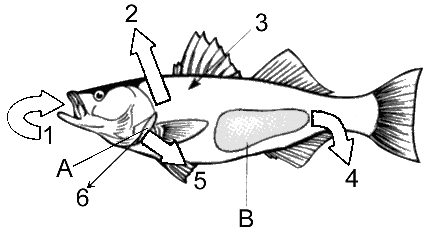 Refer to the accompanying figure in terms of a freshwater environment. What is the function of the structure labeled as A?
Refer to the accompanying figure in terms of a freshwater environment. What is the function of the structure labeled as A?
A) salt uptake
B) water gain by osmosis
C) drinking
D) removal of salts and nitrogenous wastes from the blood
E) release of nitrogenous wastes
 Refer to the accompanying figure in terms of a freshwater environment. What is the function of the structure labeled as A?
Refer to the accompanying figure in terms of a freshwater environment. What is the function of the structure labeled as A?A) salt uptake
B) water gain by osmosis
C) drinking
D) removal of salts and nitrogenous wastes from the blood
E) release of nitrogenous wastes

Unlock Deck
Unlock for access to all 111 flashcards in this deck.
Unlock Deck
k this deck
25
The ____ is shorter in females than it is in males, which explains the greater likelihood of developing bladder infections in ____.
A) ureter; females
B) ureter; males
C) renal papilla; females
D) urethra; males
E) urethra; females
A) ureter; females
B) ureter; males
C) renal papilla; females
D) urethra; males
E) urethra; females

Unlock Deck
Unlock for access to all 111 flashcards in this deck.
Unlock Deck
k this deck
26
Simple epithelial cells of the renal tubule have abundant ____ to increase the surface area for reabsorption and numerous ____ to provide energy for actively transporting materials.
A) microvilli; mitochondria
B) cilia; mitochondria
C) microvilli; Golgi complexes
D) cilia; Golgi complexes
E) cilia; capillaries
A) microvilli; mitochondria
B) cilia; mitochondria
C) microvilli; Golgi complexes
D) cilia; Golgi complexes
E) cilia; capillaries

Unlock Deck
Unlock for access to all 111 flashcards in this deck.
Unlock Deck
k this deck
27
Trace the flow of urine through the following structures.
1) bladder
2) renal papilla
3) ureter
4) renal pelvis
5) urethra
A) 4 → 2 → 5 → 1 → 3
B) 1 → 2 → 4 → 3 → 5
C) 2 → 4 → 3 → 1 → 5
D) 2 → 1 → 4 → 3 → 5
E) 4 → 1 → 2 → 3 → 5
1) bladder
2) renal papilla
3) ureter
4) renal pelvis
5) urethra
A) 4 → 2 → 5 → 1 → 3
B) 1 → 2 → 4 → 3 → 5
C) 2 → 4 → 3 → 1 → 5
D) 2 → 1 → 4 → 3 → 5
E) 4 → 1 → 2 → 3 → 5

Unlock Deck
Unlock for access to all 111 flashcards in this deck.
Unlock Deck
k this deck
28
Which portion of the renal tubule empties directly into the collecting duct?
A) Bowman's capsule
B) distal convoluted tubule
C) proximal convoluted tubule
D) descending loop of Henle
E) ascending loop of Henle
A) Bowman's capsule
B) distal convoluted tubule
C) proximal convoluted tubule
D) descending loop of Henle
E) ascending loop of Henle

Unlock Deck
Unlock for access to all 111 flashcards in this deck.
Unlock Deck
k this deck
29
The efferent arterioles transport blood directly into the:
A) afferent arterioles.
B) Bowman's capsule.
C) glomerulus.
D) peritubular capillaries.
E) renal artery.
A) afferent arterioles.
B) Bowman's capsule.
C) glomerulus.
D) peritubular capillaries.
E) renal artery.

Unlock Deck
Unlock for access to all 111 flashcards in this deck.
Unlock Deck
k this deck
30
The outermost region of the kidney is called the:
A) adventitia.
B) mucosa.
C) pelvis.
D) cortex.
E) medulla.
A) adventitia.
B) mucosa.
C) pelvis.
D) cortex.
E) medulla.

Unlock Deck
Unlock for access to all 111 flashcards in this deck.
Unlock Deck
k this deck
31
Most of the filtrate is reabsorbed through the walls of the:
A) distal convoluted tubule.
B) loop of Henle.
C) proximal convoluted tubule.
D) collecting duct.
E) glomerulus.
A) distal convoluted tubule.
B) loop of Henle.
C) proximal convoluted tubule.
D) collecting duct.
E) glomerulus.

Unlock Deck
Unlock for access to all 111 flashcards in this deck.
Unlock Deck
k this deck
32
What is the difference between cortical nephrons and juxtamedullary nephrons?
A) Juxtamedullary nephrons are more numerous than cortical ones.
B) Cortical nephrons do not have loops of Henle, while juxtamedullary ones do.
C) Juxtamedullary nephrons have larger glomeruli than do cortical ones.
D) Juxtamedullary nephrons do not have loops of Henle, while cortical ones do.
E) Juxtamedullary nephrons have more glomeruli than do cortical ones.
A) Juxtamedullary nephrons are more numerous than cortical ones.
B) Cortical nephrons do not have loops of Henle, while juxtamedullary ones do.
C) Juxtamedullary nephrons have larger glomeruli than do cortical ones.
D) Juxtamedullary nephrons do not have loops of Henle, while cortical ones do.
E) Juxtamedullary nephrons have more glomeruli than do cortical ones.

Unlock Deck
Unlock for access to all 111 flashcards in this deck.
Unlock Deck
k this deck
33
Which of the following is only partially reabsorbed in the proximal convoluted tubule?
A) glucose
B) amino acids
C) sodium ions
D) vitamins
E) nutrients
A) glucose
B) amino acids
C) sodium ions
D) vitamins
E) nutrients

Unlock Deck
Unlock for access to all 111 flashcards in this deck.
Unlock Deck
k this deck
34
____ directly deliver blood to the glomeruli.
A) Afferent arterioles
B) Efferent arterioles
C) Peritubular capillaries
D) Renal arteries
E) Renal venules
A) Afferent arterioles
B) Efferent arterioles
C) Peritubular capillaries
D) Renal arteries
E) Renal venules

Unlock Deck
Unlock for access to all 111 flashcards in this deck.
Unlock Deck
k this deck
35
The renal medulla contains the:
A) renal pyramids.
B) Bowman's capsules.
C) distal convoluted tubules.
D) glomeruli.
E) proximal convoluted tubules.
A) renal pyramids.
B) Bowman's capsules.
C) distal convoluted tubules.
D) glomeruli.
E) proximal convoluted tubules.

Unlock Deck
Unlock for access to all 111 flashcards in this deck.
Unlock Deck
k this deck
36
Which statement is accurate of filtration by the kidneys?
A) About 25% of the plasma passing through the glomerulus becomes part of the glomerular filtrate.
B) Solutes dissolved in the plasma, such as glucose, amino acids, and various salts, become part of the filtrate.
C) The normal glomerular filtration rate adds up to about 80 L every 24 hours.
D) Approximately 75% of the filtrate is reabsorbed into the blood through the renal tubules.
E) The filtration membrane prevents the passage of cells, but allows large molecules to pass through.
A) About 25% of the plasma passing through the glomerulus becomes part of the glomerular filtrate.
B) Solutes dissolved in the plasma, such as glucose, amino acids, and various salts, become part of the filtrate.
C) The normal glomerular filtration rate adds up to about 80 L every 24 hours.
D) Approximately 75% of the filtrate is reabsorbed into the blood through the renal tubules.
E) The filtration membrane prevents the passage of cells, but allows large molecules to pass through.

Unlock Deck
Unlock for access to all 111 flashcards in this deck.
Unlock Deck
k this deck
37
What is the significance of having specialized epithelium and smooth muscle in the urinary bladder?
A) It helps reabsorb water.
B) It helps reabsorb salts.
C) It permits the diffusion of gases.
D) It is capable of shrinkage and stretching.
E) It protects the bladder from nitrogenous wastes.
A) It helps reabsorb water.
B) It helps reabsorb salts.
C) It permits the diffusion of gases.
D) It is capable of shrinkage and stretching.
E) It protects the bladder from nitrogenous wastes.

Unlock Deck
Unlock for access to all 111 flashcards in this deck.
Unlock Deck
k this deck
38
Podocytes are located in the wall of:
A) Bowman's capsule.
B) the glomerulus.
C) the peritubular capillaries.
D) the renal artery.
E) the proximal convoluted tubule.
A) Bowman's capsule.
B) the glomerulus.
C) the peritubular capillaries.
D) the renal artery.
E) the proximal convoluted tubule.

Unlock Deck
Unlock for access to all 111 flashcards in this deck.
Unlock Deck
k this deck
39
The ureters connect the:
A) bladder to the body exterior.
B) kidney to the bladder.
C) bladder to the urethra.
D) kidney to the body exterior.
E) kidney to the urethra.
A) bladder to the body exterior.
B) kidney to the bladder.
C) bladder to the urethra.
D) kidney to the body exterior.
E) kidney to the urethra.

Unlock Deck
Unlock for access to all 111 flashcards in this deck.
Unlock Deck
k this deck
40
Glomerular capillary walls and podocytes form a ____ that allows fluid and small solutes in plasma to pass through and become part of the filtrate.
A) glomerular filtrate
B) tubular transport
C) renal threshold
D) filtration membrane
E) filtration slits
A) glomerular filtrate
B) tubular transport
C) renal threshold
D) filtration membrane
E) filtration slits

Unlock Deck
Unlock for access to all 111 flashcards in this deck.
Unlock Deck
k this deck
41
One of the direct products of deamination is urea .

Unlock Deck
Unlock for access to all 111 flashcards in this deck.
Unlock Deck
k this deck
42
Which of the following statements about the loop of Henle is true ?
A) The walls of the descending loop are relatively impermeable to water.
B) The walls of the descending loop are relatively permeable to sodium.
C) The walls of the ascending loop are relatively permeable to water.
D) The walls of the ascending loop are relatively permeable to sodium.
E) The entire loops is relatively permeable to sodium.
A) The walls of the descending loop are relatively impermeable to water.
B) The walls of the descending loop are relatively permeable to sodium.
C) The walls of the ascending loop are relatively permeable to water.
D) The walls of the ascending loop are relatively permeable to sodium.
E) The entire loops is relatively permeable to sodium.

Unlock Deck
Unlock for access to all 111 flashcards in this deck.
Unlock Deck
k this deck
43
What are the vasa recta?
A) capillary extensions of the afferent arterioles
B) capillary extensions of the efferent arterioles
C) regions of the renal tubule
D) vessels that supply blood to the glomerulus
E) vessels that supply blood to the proximal convoluted tubule
A) capillary extensions of the afferent arterioles
B) capillary extensions of the efferent arterioles
C) regions of the renal tubule
D) vessels that supply blood to the glomerulus
E) vessels that supply blood to the proximal convoluted tubule

Unlock Deck
Unlock for access to all 111 flashcards in this deck.
Unlock Deck
k this deck
44
Atrial natriuretic peptide has been found to:
A) decrease sodium secretion and increase blood pressure.
B) constrict afferent arterioles, decreasing the glomerular filtration rate.
C) be produced by the adrenal cortex.
D) inhibit sodium reabsorption by the collecting ducts.
E) increase the release of renin from the juxtaglomerular apparatus.
A) decrease sodium secretion and increase blood pressure.
B) constrict afferent arterioles, decreasing the glomerular filtration rate.
C) be produced by the adrenal cortex.
D) inhibit sodium reabsorption by the collecting ducts.
E) increase the release of renin from the juxtaglomerular apparatus.

Unlock Deck
Unlock for access to all 111 flashcards in this deck.
Unlock Deck
k this deck
45
Figure 48-3 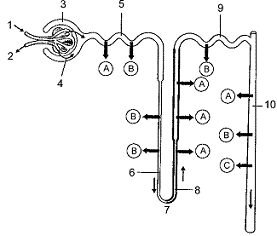 Refer to the accompanying figure. In which region will the osmolality of the filtrate be at the lowest value?
Refer to the accompanying figure. In which region will the osmolality of the filtrate be at the lowest value?
A) 3
B) 5
C) 6
D) 9
E) 10
 Refer to the accompanying figure. In which region will the osmolality of the filtrate be at the lowest value?
Refer to the accompanying figure. In which region will the osmolality of the filtrate be at the lowest value?A) 3
B) 5
C) 6
D) 9
E) 10

Unlock Deck
Unlock for access to all 111 flashcards in this deck.
Unlock Deck
k this deck
46
Briefly explain the role of Malpighian tubules in arthropods.

Unlock Deck
Unlock for access to all 111 flashcards in this deck.
Unlock Deck
k this deck
47
Compare and contrast the osmoregulatory challenges and solutions used by sharks and freshwater fishes.

Unlock Deck
Unlock for access to all 111 flashcards in this deck.
Unlock Deck
k this deck
48
Figure 48-3 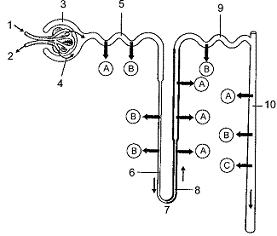 Refer to the accompanying figure. Secretion of potassium and ammonium ions occurs mainly in the portion labeled as:
Refer to the accompanying figure. Secretion of potassium and ammonium ions occurs mainly in the portion labeled as:
A) 2.
B) 5.
C) 7.
D) 9.
E) 10.
 Refer to the accompanying figure. Secretion of potassium and ammonium ions occurs mainly in the portion labeled as:
Refer to the accompanying figure. Secretion of potassium and ammonium ions occurs mainly in the portion labeled as:A) 2.
B) 5.
C) 7.
D) 9.
E) 10.

Unlock Deck
Unlock for access to all 111 flashcards in this deck.
Unlock Deck
k this deck
49
The secretion of ____ is an important homeostatic mechanism involved in maintaining normal heart rhythm.
A) hydrogen ions
B) potassium ions
C) water
D) glucose
E) urea
A) hydrogen ions
B) potassium ions
C) water
D) glucose
E) urea

Unlock Deck
Unlock for access to all 111 flashcards in this deck.
Unlock Deck
k this deck
50
Diabetes insipidus results from an insufficient production of:
A) ADH.
B) aldosterone.
C) angiotensin II.
D) ANP.
E) renin.
A) ADH.
B) aldosterone.
C) angiotensin II.
D) ANP.
E) renin.

Unlock Deck
Unlock for access to all 111 flashcards in this deck.
Unlock Deck
k this deck
51
Which of the following would be secreted across the tubule?
A) sodium ions
B) vitamins
C) creatinine
D) carbon dioxide
E) glucose
A) sodium ions
B) vitamins
C) creatinine
D) carbon dioxide
E) glucose

Unlock Deck
Unlock for access to all 111 flashcards in this deck.
Unlock Deck
k this deck
52
Figure 48-3 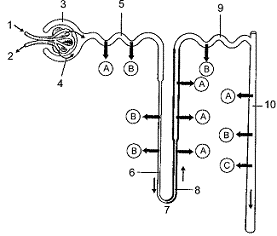 Refer to the accompanying figure. Hormonal regulation of sodium reabsorption occurs in the regions labeled as:
Refer to the accompanying figure. Hormonal regulation of sodium reabsorption occurs in the regions labeled as:
A) 3 and 5.
B) 6 and 8.
C) 6, 7, and 8.
D) 8 and 9.
E) 9 and 10.
 Refer to the accompanying figure. Hormonal regulation of sodium reabsorption occurs in the regions labeled as:
Refer to the accompanying figure. Hormonal regulation of sodium reabsorption occurs in the regions labeled as:A) 3 and 5.
B) 6 and 8.
C) 6, 7, and 8.
D) 8 and 9.
E) 9 and 10.

Unlock Deck
Unlock for access to all 111 flashcards in this deck.
Unlock Deck
k this deck
53
Figure 48-3 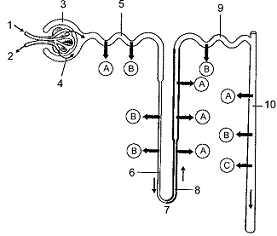 Refer to the accompanying figure. Reabsorption of solutes with nutritional value occurs at the point labeled as:
Refer to the accompanying figure. Reabsorption of solutes with nutritional value occurs at the point labeled as:
A) 1.
B) 3.
C) 5.
D) 6.
E) 9.
 Refer to the accompanying figure. Reabsorption of solutes with nutritional value occurs at the point labeled as:
Refer to the accompanying figure. Reabsorption of solutes with nutritional value occurs at the point labeled as:A) 1.
B) 3.
C) 5.
D) 6.
E) 9.

Unlock Deck
Unlock for access to all 111 flashcards in this deck.
Unlock Deck
k this deck
54
Figure 48-3 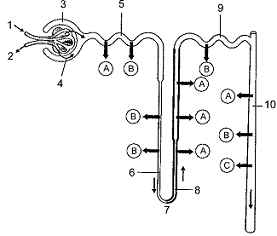 Refer to the accompanying figure. Antidiuretic hormone has its effects along the region labeled as:
Refer to the accompanying figure. Antidiuretic hormone has its effects along the region labeled as:
A) 6.
B) 7.
C) 8.
D) 9.
E) 10.
 Refer to the accompanying figure. Antidiuretic hormone has its effects along the region labeled as:
Refer to the accompanying figure. Antidiuretic hormone has its effects along the region labeled as:A) 6.
B) 7.
C) 8.
D) 9.
E) 10.

Unlock Deck
Unlock for access to all 111 flashcards in this deck.
Unlock Deck
k this deck
55
Figure 48-3 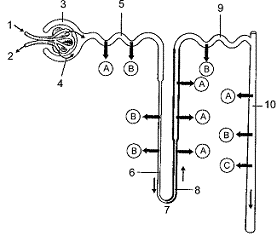 Refer to the accompanying figure. Reabsorption of water occurs at the point(s) labeled as:
Refer to the accompanying figure. Reabsorption of water occurs at the point(s) labeled as:
A) 3 and 9.
B) 5 and 8.
C) 6 and 10.
D) 8 and 10.
E) only 10.
 Refer to the accompanying figure. Reabsorption of water occurs at the point(s) labeled as:
Refer to the accompanying figure. Reabsorption of water occurs at the point(s) labeled as:A) 3 and 9.
B) 5 and 8.
C) 6 and 10.
D) 8 and 10.
E) only 10.

Unlock Deck
Unlock for access to all 111 flashcards in this deck.
Unlock Deck
k this deck
56
Discuss the advantages and disadvantages associated with the production of ammonia, urea, and uric acid.

Unlock Deck
Unlock for access to all 111 flashcards in this deck.
Unlock Deck
k this deck
57
What is the function of antidiuretic hormone?
A) It increases the permeability of the collecting ducts to sodium so more is reabsorbed.
B) It causes a high volume of less concentrated urine to be produced.
C) It increases aldosterone secretion.
D) It decreases renin secretion.
E) It increases the permeability of the collecting ducts to water so more is reabsorbed.
A) It increases the permeability of the collecting ducts to sodium so more is reabsorbed.
B) It causes a high volume of less concentrated urine to be produced.
C) It increases aldosterone secretion.
D) It decreases renin secretion.
E) It increases the permeability of the collecting ducts to water so more is reabsorbed.

Unlock Deck
Unlock for access to all 111 flashcards in this deck.
Unlock Deck
k this deck
58
The nephridial organs of flatworms are called metanephridia .

Unlock Deck
Unlock for access to all 111 flashcards in this deck.
Unlock Deck
k this deck
59
Compare and contrast osmoregulation of freshwater fish and marine fish.

Unlock Deck
Unlock for access to all 111 flashcards in this deck.
Unlock Deck
k this deck
60
When you drink a large volume of water, the release of ____ by the pituitary gland ____.
A) aldosterone; increases
B) aldosterone; decreases
C) ADH; increases
D) ADH; decreases
E) ANP; increases
A) aldosterone; increases
B) aldosterone; decreases
C) ADH; increases
D) ADH; decreases
E) ANP; increases

Unlock Deck
Unlock for access to all 111 flashcards in this deck.
Unlock Deck
k this deck
61
Aldosterone is responsible for increasing the reabsorption of sodium.

Unlock Deck
Unlock for access to all 111 flashcards in this deck.
Unlock Deck
k this deck
62
ADH makes the walls of the collecting duct more permeable to water .

Unlock Deck
Unlock for access to all 111 flashcards in this deck.
Unlock Deck
k this deck
63
Insects have an excretory system consisting of Malpighian tubules .

Unlock Deck
Unlock for access to all 111 flashcards in this deck.
Unlock Deck
k this deck
64
The renal medulla is the inner portion of the kidney.

Unlock Deck
Unlock for access to all 111 flashcards in this deck.
Unlock Deck
k this deck
65
Sharks excrete a(n) small volume of dilute urine.

Unlock Deck
Unlock for access to all 111 flashcards in this deck.
Unlock Deck
k this deck
66
How is a fall in blood pressure counteracted by the secretion of aldosterone?

Unlock Deck
Unlock for access to all 111 flashcards in this deck.
Unlock Deck
k this deck
67
The walls of the descending limb of the loop of Henle are relatively permeable to sodium .

Unlock Deck
Unlock for access to all 111 flashcards in this deck.
Unlock Deck
k this deck
68
Discuss why a doctor would prescribe an ACE inhibitor to a patient with a history of high blood pressure.

Unlock Deck
Unlock for access to all 111 flashcards in this deck.
Unlock Deck
k this deck
69
Match between columns

Unlock Deck
Unlock for access to all 111 flashcards in this deck.
Unlock Deck
k this deck
70
Birds store most of their waste nitrogen as uric acid .

Unlock Deck
Unlock for access to all 111 flashcards in this deck.
Unlock Deck
k this deck
71
Filtration slits are located between adjacent podocytes .

Unlock Deck
Unlock for access to all 111 flashcards in this deck.
Unlock Deck
k this deck
72
Filtrate flows from the proximal convoluted tubule directly into the distal convoluted tubule .

Unlock Deck
Unlock for access to all 111 flashcards in this deck.
Unlock Deck
k this deck
73
In humans, urea and uric acid are produced by the kidneys .

Unlock Deck
Unlock for access to all 111 flashcards in this deck.
Unlock Deck
k this deck
74
Describe the causes and effects of diabetes insipidus.

Unlock Deck
Unlock for access to all 111 flashcards in this deck.
Unlock Deck
k this deck
75
Match between columns

Unlock Deck
Unlock for access to all 111 flashcards in this deck.
Unlock Deck
k this deck
76
Urine flows from the ureters directly into the urethra .

Unlock Deck
Unlock for access to all 111 flashcards in this deck.
Unlock Deck
k this deck
77
Blood flows from the efferent arterioles directly into the peritubular capillaries .

Unlock Deck
Unlock for access to all 111 flashcards in this deck.
Unlock Deck
k this deck
78
Most reabsorption occurs in the distal convoluted tubule .

Unlock Deck
Unlock for access to all 111 flashcards in this deck.
Unlock Deck
k this deck
79
Freshwater fishes excrete most of their nitrogenous wastes through the kidneys .

Unlock Deck
Unlock for access to all 111 flashcards in this deck.
Unlock Deck
k this deck
80
What is meant by the counterflow of fluid through the limbs of the loop of Henle, and what is its role in the normal function of a human kidney?

Unlock Deck
Unlock for access to all 111 flashcards in this deck.
Unlock Deck
k this deck



